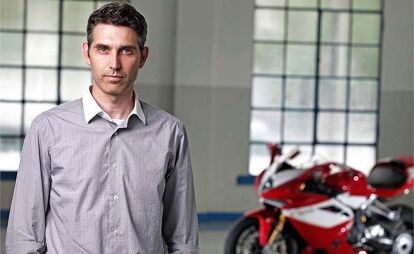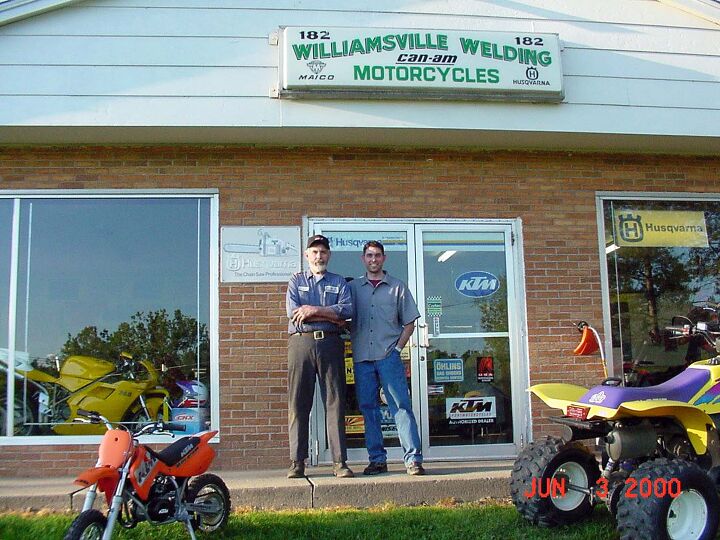Whatever: A Heartwarming Italian Immigrant Success Story for the 21st Century
Buffalo, NY's very own Brian Gillen is MV Agusta's Research & Development Director
From across the room, Brian Gillen is just another handsome, well-dressed Italian guy at the typical MV Agusta unveiling in the south of France or along the Cote d’Azur, but when you begin talking to him, something’s missing? Oh, it’s the accent in his English. Even without it, he seems just as conversant in Italian or Espanol (not that I would know) talking with his co-workers and other journalists.
The accent is missing because Brian’s from Buffalo, NY. He got a degree in Mechanical Engineering from the University at Buffalo, and in 1998 went to work for Magneti Marelli USA as a project leader on Harley-Davidson projects. By 2000, he’d transferred to Magneti Marelli Italy – specifically to the motorcycle group in Bologna. By 2004, he was Technical Director at Gas Gas Motos, in Girona, Spain. By 2008, he’d become Manager of Engine Design at MV Agusta, where today he finds himself entitled “Research and Development Director.” Not bad for a kid from Buffalo.
Really it’s only fitting, or is that ironic?, that Gillen would end up here: His family owned a Maico/Husqvarna/KTM/Ducati/Moto Guzzi dealership in Holland, NY, “Williamsville Competition,” from 1973 until just a couple years ago. Gillen can only smile: “Nobody wanted a Husky or a KTM or a Ducati in those days.”
Not that that kept Brian from competing on them and digging into their internals. As a result, not many people would probably have a better understanding of what those bikes needed to be successful. “Mike Rosso, the technical services manager for KTM USA,” Brian says, “put up with a lot of phone calls from a very curious 16-to-20 year-old service tech who was an aspiring engineer in a small dealership in upstate New York.”
In any case, his timing in coming to MV couldn’t have been much better. In 2010, Harley-Davidson sold MV back to the Castiglionis, and two years later MV’s first modern Triples went on sale – the F3 675 sportbike and the 675 Brutale, followed in the last couple of years by the 800 versions (both Triples were developed concurrently).
Says Brian: “I started working at MV in ’08 just as the sale to H-D was going through. My boss at the time was Andrea Goggi, but for special projects I reported directly to Claudio Castiglioni. H-D was a great opportunity for MV and because of their ownership, we were able to develop and industrialize the 3-cylinder platform. Unfortunately, the sub-prime crash humbled H-D and forced them to restructure, closing Buell and selling MV.”
Gillen doesn’t seem to be much of a credit-taker, but a little prying gets this: “I was the head of the engine design department when we designed and developed the 3-cylinder engine platform… If there is one part of the engine that I’m proudest of it is integrating the counter-rotating crankshaft – a technology currently used on MotoGP bikes. The counter-rotating crankshaft has a big impact on vehicle dynamics (anti-wheelying, turning on corner exit…). Normally, the engine is just a lump that the chassis has to haul around the track, but with the counter-rotating crankshaft, the “lump” turns into an integral component of the vehicle dynamics with the polar moment of inertia offsetting the inertia of the wheels during turn-in, and loading the front of the chassis under acceleration. The Yamaha M1 and Ducati are both using this technology; Honda are believed to employ it but this has not been officially confirmed or denied.”
The first 675s were beautiful motorcycles, but came under heavy criticism for less-than-ideal fuel-injection tuning; they’ve gotten increasingly better as MV refines its tuning (and offers it free to owners). The new 2016 Brutale 800 I recently got to ride in Spain ran nearly flawlessly, in spite of it being MV’s first Euro 4-compliant bike.
Anyway, Gillen wasn’t busy enough overseeing all that (sarcasm) at a time when MV’s sales graph was heading rapidly northeast under a slew of new models, so in 2013 Castiglioni also put him in charge of reviving MV’s racing program. No pressure there. MV worked with the ParkinGo World Supersport team in that first season, scoring two podiums with Roberto Rolfo, and one podium with Christian Iddon. At the Phillip Island opening round of the 2014 season, Jules Cluzel won the World Supersport race on the F3, MV Agusta’s first international win since Giacomo Agostini’s last one at the Nurburgring circuit 37 years earlier.
Giovanni Castiglioni, President of MV Agusta, said: “This was a marvelous win, an indescribable thrill. I want to dedicate this victory to my father, whose faith in MV and the possibility of a successful return to racing was always unshakeable, and to the late father of Brian Gillen, our Reparto Corse manager.” Brian’s dad had passed January 31, less than a month before that first win. You could probably count on the fingers of one hand how many guys would’ve taken more pleasure from that victory than he would’ve.
Cluzel went on to finish second in WSS points in 2014, taking 3 wins, 5 pole positions and 7 podiums. Last season, he was on final approach to the WSS championship when he crashed and both broke ankles with just three races to go. 2015 was also a development year for Leon Camier as MV returned to the big-bike class with its F4R Superbike; Camier finished inside the top 10 in twelve races, with a best of 5th, at Magny Cours. For a factory the size of MV Agusta, these are outstanding results.
Anyway, now that the team is successfully re-launched and now with AMG backing, former MotoGP contenders Forward Racing are taking care of MV’s racing activities, while more of Gillen’s focus has shifted back to launching the six new motorcycles MV promised for 2016: “We have tried to re-structure the 2016 racing program in a way that allows us to maintain the concentration and resources that are required to move forward in parallel. I will be present at a select number of primarily European Rounds of the 2016 Championship.”
When I reached him via email over the weekend to continue this interview, I wasn’t sure if Gillen would be home in Bologna or with the team in Phillip Island. Home in Bologna, as it turned out, “… eating a four-course Italian dinner with a Spanish ham appetizer and a main course of homemade tortellini (the wife’s handiwork), followed up with some grilled spareribs (gotta teach my boys the finer points of bbq!) followed up with some gelato for dessert.”
Four months after arriving in Italy, in 2000, Brian met Eleanora and married her. Probably a good move; she’s a science and math teacher who studies languages in her spare time, and is accredited and fluent in English, French, German, Spanish, Catalan, Italian (Bolognese and Calabrese dialects). Brian hopes their two boys will get some of her brains. She also knows how to make tortellini. If I wasn’t jealous before…
To ensure the boys will make the best of whoever’s gray matter they inherit (seems like the deck is stacked in their favor), the family stays put in Bologna, home of the world’s oldest university (established 1088) and a not-unpleasant place to live. Mondays at 0630, Brian’s in his Audi blasting the 307 kilometers to the MV Agusta factory in Varese, where he’ll put in 15 hour days until returning home Friday night. To relieve the workplace tension, though, there’s an MX park behind the factory where he, Giovanni Castiglioni, MV’s lead test rider Federico Sandi, and others can be found spinning laps – and in fact it’s easier to ride moto in Italy than in most of the U.S., according to Brian, who says there are nine tracks within 20 minutes including the world class one at Firenza. Prego…
What next? Plenty, if recent history is any indication. In 2010, MV produced three models. Now it produces 20 distinct versions of seven platforms. At the Brutale 800 roll-out a couple months ago, MV said there’d be six new models this year, a thing that’s far from simple even if they all share three basic engines. Persnickety about your fuel injection? So is Gillen. Getting it perfect isn’t so easy; at the Rivale launch a couple years ago, he told me that due to various legal requirements and fuel specs around the world, that bike needed 32 distinct fuel maps worked out before it was ready for worldwide release (and that was before Euro 4, which required the new Brutale emit 30% less pollution and 5 decibels less racket). ABS is the same deal, and now it’s mandatory in Europe: Each motorcycle’s ABS mapping is unique, and needs to be programmed to work with its cg, weight distribution, and a host of other factors.
If it was easy, everybody would manufacture motorcycles. It’s good to have an historical perspective, and the sense to respect and seek out the right people. One of Gillen’s early heros was Philip Irving, the man behind Vincent HRD. And after he made it to Europe, “I was proud to develop a very good personal relationship with Gordon Blair, at Queens University. I had the great opportunity to work with Massimo Bordi when he became the Executive VP of MV Agusta in 2010… earlier, there was Rod Bush, former President of KTM USA.”
It seems like an excellent marriage from where I spectate, between a brilliant, hands-on hardscrabble racer/mechanic/engineer from the new world (where there was really no place for a talented kid to put his skills to work), and the blue-blood Italian aristocratic manufacturer that used to, at least, think of itself as the Ferrari of motorcycles, the home of Agostini and Hailwood. Where does Brian Gillen go from here? Nowhere soon. “I feel like there are still plenty of things to accomplish at MV. We’re just getting started.”
Go Brian! Italy, land of opportunity!
More by John Burns




























































Comments
Join the conversation
If MV is to soar to the stratosphere, they have to beat Ducati in quality and performance and they have to stop comparing themselves to HD. I still can't shake off my mind the abomination of the two names side by side. AMG makes for a more palatable pairing.
NB: When are we going to see a full review of the Turismo Veloce, since you're now chums with GC? Maybe you can get Big Sean as pillion, or vice versa. A comparison to FJ-09, BMW S1000XR, and Triumph 800 XRT would be nice.
Wow Burnsie. I guess my mom was right. I am a failure. Great article! I'll be rooting for MV in WSB and WSS, oh along with some kid from Kentucky.